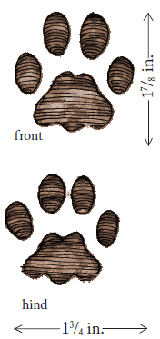Wildlife - Species

Species Specific Regulations
Bobcat
Licenses: Hunting License required.
Limits: Weapon restrictions according to game zones please check for Limitations.

Bobcat tracks
Bobcat (Lynx rufus)
Description
Males are larger than females. Their color ranges from grayish brown to reddish brown with black spots on the legs and lower sides. The tail is short or “bobbed” from which the bobcat gets its name. Their legs are longer than those of domestic cats.
Average Size
Southern bobcats stand about 16 to 22 inches at the shoulder and weigh 12 to 25 lbs.
Life Expectancy
The oldest recorded bobcat in South Carolina was 15 years old.
Preferred Habitat
Usually found in heavily forested areas, the highest densities of bobcats are in bottomland forests of the lower Coastal Plain. Piedmont habitats with a good interspersion of forest and clearcut areas support stable bobcat populations. Clearcuts provide alternate prey numbers species in years when forest prey numbers are low.
Range
Bobcats are found throughout the lower 48 states, but are rare in many upper midwestern states. They are found throughout South Carolina, being most abundant in the Coastal Plain, but apparently increasing in the Piedmont.
Food Habits
Cotton rats, mice, cottontail rabbits, and squirrels are the most important components of the bobcat’s diet. White-tailed deer appear in their diet during two periods: the hunting season when deer may be crippled or killed but not retrieved, and to a much lesser extent in the early summer during the deer fawning season. Bobcats hunt more by sight than do other predators such as the fox, which depends more heavily on the senses of smell and hearing. Bobcats will sometimes eat poultry and young pigs but generally do not pose a threat to agriculture.
Reproduction
Peak Breeding Activity
Bobcats are polygamous, breeding from late February to early April.
The young leave the den after 4 to 5 weeks, and the family breaks up by October.
Gestation
63 days and the average litter size is 3.
Miscellaneous
Bobcats are subject to feline distemper, and prey availability is an important population control. The annual turnover or mortality rate in bobcats is estimated at 22%.
The bobcat has one of the most valued pelts of all our furbearer species. The demand for bobcat pelts intensified in recent years because of the ban on international trade of various species of endangered spotted cats. While the bobcat is not endangered, its harvest is carefully monitored because of the high demand for spotted cat furs worldwide. Commercial harvesting of bobcats is allowed statewide in South Carolina, providing a particular challenge to sport trappers. Hunting of bobcats with hounds was once very popular but is now uncommon. Bobcats are often blamed for the loss of livestock, which is actually the result of predation by feral or free-ranging dogs.
Publications and Literature
Baker, O.E., Carmichael, D. Breck, South Carolina Furbearers. Wildlife and Freshwater Fisheries Division. Columbia, South Carolina
Fur Harvest Hunting and Trapping are provided in the Fur Harvest Brochure which is a summary of the state statutes regarding the commercial harvest of furbearers. Applicable statutes are listed in parentheses at the end of each section of this brochure. Copies of actual statutes of the SC Code of Laws are available online from the SC Legislature at www.scstatehouse.gov or by writing: Furbearer Program, SC Department of Natural Resources, P.O. Box 167, Columbia, SC 29202.
Some of the files above are provided in the Adobe® Acrobat® (PDF) format. Adobe® Reader® is required to open these files and is available as a free download from the Adobe® Web site.
Jay Butfiloski - Furbearer Project Supervisor
SCDNR Furbearer Project
P. O. Box 167
Columbia, SC 29202-0167
Phone: 803-734-3886
Fax: 803-734-6020
E-mail: ButfiloskiJ@dnr.sc.gov

